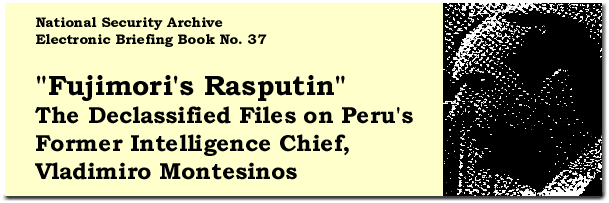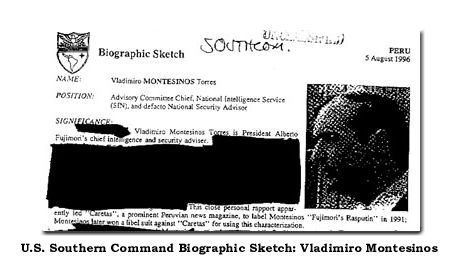|
||
State Department Human Rights Reports on Peru
|
The documents posted today were obtained through Freedom of Information Act requests made by journalist Jeremy Bigwood, who earlier this year donated them to the Archive. These documents shed some light on Montesinos' involvement in human rights violations and corruption scandals, but also demonstrate the amount of information being currently withheld on this subject by the U.S. government. According to Peter Kornbluh, who analyzes Latin America at the Archive, the Clinton Administration "could, and should, make a major contribution to the truth of Montesinos's career, as well as to the future of Peruvian democracy, by expeditiously declassifying the U.S. holdings on Montesinos." Kornbluh said that U.S. agencies have vast amounts of secret documentation that would serve as essential evidence in any proceedings against Montesinos for human rights abuses and graft. The Archive, which has led campaigns to declassify secret U.S. documents on Guatemala, Chile, El Salvador and elsewhere in Latin America, said it would press for full disclosure of hundreds of U.S. records on Montesinos, including CIA documents on covert relations with President Fujimori's disgraced intelligence chieftain. The Archive is set to file dozens of Freedom of Information Act requests on Montesinos and his ties to the United States. An independent non-governmental research
institute and library located at the George Washington University, the
Archive collects and publishes declassified documents (There are more documents in the Peru collection available at our offices. For further information, please contact Tamara Feinstein, Research Associate for the Peru Project, at (202) 994-7219 or tfeins7i@gwu.edu.)
THE DOCUMENTSDocument 1: Army Intelligence and Threat Analysis Center, Counterintelligence Periodic Summary [Extract], Who is Controlling Whom?, October 23, 1990, Secret, 3 pp. This document written at the beginning of President Fujimori's administration, already implies that Vladimiro Montesinos is controlling the government. It reports that Montesinos first ingratiated himself to Fujimori by defending Mrs. Fujimori in a court case revolving around shady real estate deals and that he provided advice to Fujimori on how to conduct his presidential campaign. According to the document, a group of retired military officers have already come forward to highlight the dangers of Montesinos' influence. These generals insist that, "the Peruvian CIA cannot dominate the Peruvian state," and imply the army might "intervene and ‘decapitate' the intelligence structure at some point."
Document 2: Army Intelligence and Threat Analysis Center, Counterintelligence Periodic Summary [Extract], Peru: Does Fujimori's Unofficial Advisor Control the Peruvian National Intelligence Community?, July 27, 1991, Secret, 3 pp. While Fujimori insists Montesinos is merely his personal legal advisor, Montesinos is clearly more than that. This document suggests that Montesinos has influenced high presidential appointments in the civilian and military sectors of the government. In addition, this report notes that Peruvian General Luis Palomino Rodriguez warned the U.S. defense attaché that Montesinos had intentions to frustrate U.S-Peruvian counter-drug efforts.
Document 3: Origin Unknown, Peru: Military Unease Growing, December 23, 1992, Classification Unknown, 1 pp. Updated, May 10, 2001 The Department of Defense's Joint Intelligence Command released this document on April 5, 2001 in response to a FOIA request made by Jeremy Bigwood. This document focuses on the aftermath of the failed November 1992 coup attempt made by the military against President Fujimori. The document reveals growing discontent within the military over the treatment of the coup plotters. The Peruvian Army appears "rife" with rumors that several coup plotters have been tortured and have been transferred to the civilian prison "Canto Grande", due to fears that armed forces sympathizers would help them escape if they were placed in military prison. Vladimiro Montesinos reportedly supervised torture sessions attempting to force coup plotters to name opposition politicians as co-conspirators, and he is accused of delivering some of the blows himself. The document notes that while the Army has officially denied torture allegations, "the use of torture is plausible."
Document 4: U.S. Embassy (Lima) Cable, Army General Denies Providing Information on La Cantuta to Robles, June 1, 1993, Secret, 5 pp. General Rodolfo Robles Espinoza, once the third most powerful man in the Peruvian army, based part of his claims that General Commander of the Army Nicolás de Bari Hermoza Rios and Montesinos were involved in the creation and operation of a death squad on alleged conversations with one time head of the Army Intelligence Directorate, General Willy Chirinos. According to Robles, during his brief tenure at army intelligence, Chirinos learned of the existence of a death squad under the direction of Vladimiro Montesinos. This death squad was responsible for the massacres at La Cantuta and Barrios Altos. Fearing that the existence of a death squad would inevitably embarrass the army, Chirinos urged that it be disbanded. Montesinos, however, ordered that it remain intact. Robles goes on to claim that Chirinos was dismissed as head of army intelligence after making this recommendation. Chirinos, in statements published in Lima newspapers denies that he spoke to Robles about La Cantuta, or the existence of a death squad connected with Montesinos. The large section excised at the end of this document might possibly reveal embassy commentary on the validity of these claims.
Document 5: DEA Report of Investigation, Corrupt Officials, Sensitive, August 27, 1996, 1 p. The Drug Enforcement Agency begins investigations into accusations by drug trafficker Demetrio Chavez-Penaherra (aka "Vaticano") that Montesinos accepted $50,000 a month in bribes. This document notes that Montesinos was a well-known defense lawyer for narco-traffickers before becoming Fujimori's advisor. This document not only reveals that the DEA was investigating Montesinos for these specific charges, but that they also had a previous file on him prior to this investigation.
Document 6: Army Intelligence and Threat Analysis Center, Counterintelligence Periodic Summary [Extract], Peruvian Intelligence Service Accused of Political Espionage, December 16, 1996, Secret, 3 pp. This document describes an overseas SIN intelligence network, managed by Vladimiro Montesinos and staffed by 17 retired military officers, whose objective is to monitor the activities of opposition elements abroad. This network is active in Bolivia, Brazil, Chile, Colombia, Ecuador, South Korea and the US and responds directly to "presidential requirements" including "weapons acquisitions and disinformation".
Document 7: U.S. Southern Command Information Paper, Purpose: To Inform the [Commander-in-Chief] on the Validity of General Robles's Allegations against Montesinos, January 6, 1997, Classification Unknown, 1 p. This document once again exposes allegations regarding Montesinos's relation to the "La Colina" death squad, which employs tactics of torture and extra-judicial executions. It also notes that Montesinos has been compared to sinister figures such as "Rasputin, Darth Vadar, Torquemada and Cardinal Richelieu."
Document 8: U.S. Southern Command Biographic Sketch, Vladimiro Montesinos Torres, August 5, 1996, Classification Unknown, 2 pp. This is the full version of the heavily excised document used as a header for this briefing book. It clearly reveals the large amount of material already being withheld from the public.
|
|
|
home | about | documents | news | publications | FOIA | research | internships | search | donate | mailing list
|



 obtained through the Freedom of Information Act. The Archive won the
obtained through the Freedom of Information Act. The Archive won the